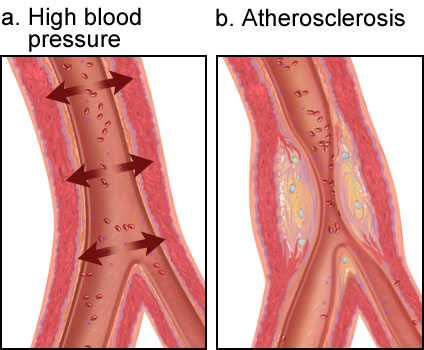
Vascular Problems
The vascular (circulatory) system is made up of blood vessels called arteries and veins. Arteries (see fig. 1a) carry oxygenated blood from the heart to the body. Blood is pushed through the arteries by pressure created by the heart’s beating. Veins carry deoxygenated blood back to the heart. Veins (see fig. 1b) have valves that prevent blood from flowing backwards. Blood flow is slower than in the arteries. The contractions of surrounding muscles help keep the blood moving forward. There are some common problems that can occur with the blood vessels (listed below).
Figure 2a: High blood pressure, or hypertension, is a condition in which blood pressure levels are measure above the normal ranges.
Figure 2b: Atherosclerosis is a disease that affects the arteries. It is caused by fatty deposits in the vessel wall and eventually progresses to narrowing of the blood vessel itself.
Figure 3a: An aneurysm is caused by a weakened area in a blood vessel wall. This causes the wall to balloon outward. As the aneurysm becomes larger it may break open (rupture).
Figure 3b: An embolism is a blood clot that has traveled to another place in the body. The clots can lodge in smaller arteries, stopping blood flow.
Figure 4a: Varicose veins occur when the valves in a vein do not work properly. As a result, blood pools in the veins and causes the veins to become swollen and twisted.
Figure 4b: A thrombosis is a blood clot that has formed inside a blood vessel. Most commonly they can occur in the veins of the leg (deep vein thrombosis. These blood clots can break off and travel through the blood (embolism).
Visit Medmovie.com Website for more information.



